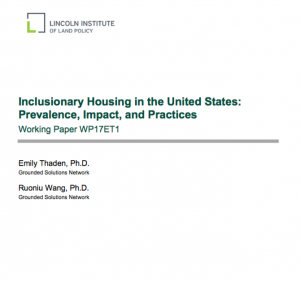 Inclusionary housing is gaining attention as a bulwark against displacement amid soaring housing costs. In the Working Paper Inclusionary Housing in the United States: Prevalence, Impact, and Practices, from The Lincoln Institute of Land Policy, authors Emily Thaden and Ruoniu (Vince) Wang, of Grounded Solutions Network, survey the landscape of inclusionary housing in the United States, identifying 886 jurisdictions in 25 states that have enacted the policy. The paper documents nearly 200,000 affordable housing units that have been created and nearly $2 billion in fees paid by developers in lieu of building affordable units – likely underestimates because of missing data.
Inclusionary housing is gaining attention as a bulwark against displacement amid soaring housing costs. In the Working Paper Inclusionary Housing in the United States: Prevalence, Impact, and Practices, from The Lincoln Institute of Land Policy, authors Emily Thaden and Ruoniu (Vince) Wang, of Grounded Solutions Network, survey the landscape of inclusionary housing in the United States, identifying 886 jurisdictions in 25 states that have enacted the policy. The paper documents nearly 200,000 affordable housing units that have been created and nearly $2 billion in fees paid by developers in lieu of building affordable units – likely underestimates because of missing data.
The paper also breaks down policies by different characteristics, including whether they are mandatory or voluntary, whether they create for-sale or rental units, and crucially, the length of time for which they require units to remain affordable. The paper finds that least 90 percent of inclusionary housing programs require that units remain affordable for 30 years or longer.
“This trend in local inclusionary housing programs differs from the relatively short-term affordability requirements in federal housing programs, which range from five to 30 years,” Thaden and Wang conclude. “The embrace of long-term and lasting affordability requirements by local governments illustrates their commitment to preserve the affordable housing stock in their communities as well as the more prudent use of public and private investment in affordable housing.”
Although comprehensive data on impact and program characteristics was not available for the majority of programs, the study did find that 373 jurisdictions reported a total of $1.7 billion in impact or in-lieu fees for the creation of affordable housing. Jurisdictions also reported creating a total of 173,707 units of affordable housing, which predominantly excludes additional units created with the $1.7 billion in fees:
Due to missing data, these numbers substantially underestimate the total fees and units created by the entire inclusionary housing field